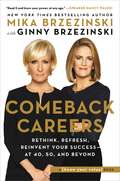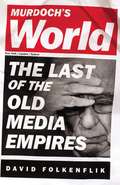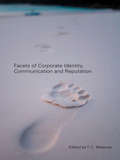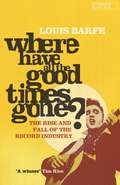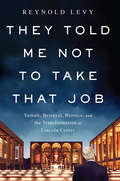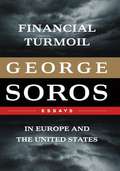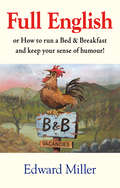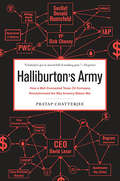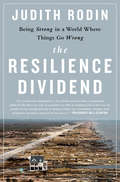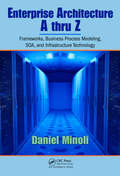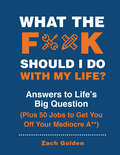- Table View
- List View
Comeback Careers: Rethink, Refresh, Reinvent Your Success--At 40, 50, and Beyond
by Mika BrzezinskiSTRONG, WISER, BETTER An Essential Guide for Reentering, Reinventing, or Rebooting Your Career at Any Age So many women hit midlife and realize: it's time for a career change. Maybe you're yearning to try something new, or you're sensing that layoffs are coming and you need a backup plan. Perhaps you paused, or downsized your career to raise children, and you're ready to rejoin the workforce. How do you reboot, relaunch, return to, or reinvent a career at age 40? Or 50? Or 60? And how can you create a career and life that will provide you with purpose and financial security for years to come? In Comeback Careers, New York Times bestselling author and co-host of MSNBC's Morning Joe Mika Brzezinski and her sister-in-law Ginny Brzezinski have teamed up to show you that career reinvention is possible at any age. You have the skills, experience and maturity; it's time to own them. For this book, Mika and Ginny interviewed dozens of career-changers working in a variety of fields, from finance to academics to art. They share successful relaunchers' secrets to overcoming obstacles both internal and external, and their step-by-step processes and candid advice. They also reveal key strategies from top job coaches, resume-writers, and LinkedIn experts, tailored to the special challenges of mid-career jobseekers.It's time to rewrite the narrative. You are stronger, wiser, and better at the midpoint, and Comeback Careers is a roadmap to your career reinvention and fulfillment.
Scotch Missed: The Original Guide to the Lost Distilleries of Scotland
by Brian TownsendThis is a revised fourth edition of the hardback first published in 1993 to celebrate the 500th anniversary of the first documentary records of the making of Scotch whisky in 1494. The second edition followed in 1997 and the third in 2000 (reprinted almost annually).Brian Townsend has now detailed the remnants and ruins of almost every Victorian working distillery in Scotland. In this new edition he has fully updated the most recent closures and has sourced over 35 new archive photographs of many of Scotland's lost distilleries. The distilleries featured vary from the remnants of once great industrial concerns such as Port Dundas in Glasgow, Saucel Distillery in Paisley to a mere tumble of bricks and mortar lying in a remote location like Glen Tarras at Langholm.Over the length and breadth of Scotland, its greatest export has left its mark and this book is a tribute not only to those who struggled against great odds and were finally beaten, but also to those who survived and have prospered. Townsend's detailed research brings to life a large portion of Scottish industrial heritage which would otherwise have been ignored and he has enlivened this with interviews of the last people to work those long gone stills. He has also tracked down the whisky which in some cases still exists and the book is fully illustrated with records past and present of this remarkable trade.Includes full OS map reference index to all distilleries listed and a full index.
Belching Out the Devil: Global Adventures with Coca-Cola
by Mark ThomasMark Thomas-a legendarily seditious comedian and human rights activist-is a recovering Coca-Cola addict, a self-described "middle-aged fat dad with asthma” who decides to trek around the globe investigating the stories and people Coca-Cola's iconic advertising campaigns don't mention: child laborers in the sugarcane fields of El Salvador, Indian workers exposed to toxic chemicals, Columbian labor union leaders in Coke bottling plants falsely accused of terrorism and jailed alongside the paramilitaries who want to kill them.At once hilarious and disturbing, Thomas builds a very detailed and damning case against the world's most ubiquitous drink.
Understanding Complex Datasets: Data Mining with Matrix Decompositions
by David SkillicornMaking obscure knowledge about matrix decompositions widely available, Understanding Complex Datasets: Data Mining with Matrix Decompositions discusses the most common matrix decompositions and shows how they can be used to analyze large datasets in a broad range of application areas. Without having to understand every mathematical detail, the book
Managing Global Development Risk
by James M. Hussey Steven E. HallWhile global sourcing has expanded dramatically in terms of activities, consistent challenges remain for organizations that choose such a business decision. These challenges include maximizing the opportunity afforded by globalization, fully realizing potential gains, and managing the risks inherent to global development. In addition, while compani
Operational Excellence: Using Lean Six Sigma to Translate Customer Value through Global Supply Chains
by James William MartinTo successfully compete in today‘s global marketplace, organizations can and must do more to improve their internal operational efficiencies. Operational Excellence: Using Lean Six Sigma to Translate Customer Value through Global Supply Chains consolidates hundreds of tools and methods into 110 key concepts designed to translate thevoice o
Information Assurance Architecture
by Keith D. WillettNow that information has become the lifeblood of your organization, you must be especially vigilant about assuring it. The hacker, spy, or cyber-thief of today can breach any barrier if it remains unchanged long enough or has even the tiniest leak. In Information Assurance Architecture, Keith D. Willett draws on his over 25 years of technical, secu
The Theft of a Decade: How the Baby Boomers Stole the Millennials' Economic Future
by Joseph C. SternbergA Wall Street Journal columnist delivers a brilliant narrative of the mugging of the millennial generation-- how the Baby Boomers have stolen the millennials' future in order to ensure themselves a comfortable presentThe Theft of a Decade is a contrarian, revelatory analysis of how one generation pulled the rug out from under another, and the myriad consequences that has set in store for all of us. The millennial generation was the unfortunate victim of several generations of economic theories that made life harder for them than it was for their grandparents. Then came the crash of 2008, and the Boomer generation's reaction to it was brutal: politicians and policy makers made deliberate decisions that favored the interests of the Boomer generation over their heirs, the most egregious being over the use of monetary policy, fiscal policy and regulation. For the first time in recent history, policy makers gave up on investing for the future and instead mortgaged that future to pay for the ugly economic sins of the present. This book describes a new economic crisis, a sinister tectonic shift that is stealing a generation's future.
Murdoch's World: The Last of the Old Media Empires
by David FolkenflikRupert Murdoch is the most significant media tycoon the English-speaking world has ever known. No one before him has trafficked in media influence across those nations so effectively, nor has anyone else so singularly redefined the culture of news and the rules of journalism. In a stretch spanning six decades, he built News Corp from a small paper in Adelaide, Australia into a multimedia empire capable of challenging national broadcasters, rolling governments, and swatting aside commercial rivals. Then, over two years, a series of scandals threatened to unravel his entire creation.Murdoch's defenders questioned how much he could have known about the bribery and phone hacking undertaken by his journalists in London. But to an exceptional degree, News Corp was an institution cast in the image of a single man. The company's culture was deeply rooted in an Australian buccaneering spirit, a brawling British populism, and an outsized American libertarian sensibility-at least when it suited Murdoch's interests.David Folkenflik, the media correspondent for NPR News, explains how the man behind Britain's take-no-prisoners tabloids, who reinvigorated Roger Ailes by backing his vision for Fox News, who gave a new swagger to the New York Post and a new style to the Wall Street Journal, survived the scandals-and the true cost of this survival. He summarily ended his marriage, alienated much of his family, and split his corporation asunder to protect the source of his vast wealth (on the one side), and the source of his identity (on the other). There were moments when the global news chief panicked. But as long as Rupert Murdoch remains the person at the top, Murdoch's World will be making news.
Facets of Corporate Identity, Communication and Reputation
by Tc MelewarCorporate branding and communication is big business. Companies throughout the world invest millions in strategies which aim to reinvent their profile in subtle yet important ways. The investment must be working, but what is it being spent on, and how do these rebranding exercises work?Including contributions from academics and practitioners, this
Where Have All the Good Times Gone?: The Rise And Fall Of The Record Industry
by Louis BarfeLouis Barfe's elegantly written, authoritative and highly entertaining history charts the meteoric rise and slow decline of the popular recording industry. Barfe shows how the 1920s and 1930s saw the departure of Edison from the phonograph business he created and the birth of EMI and CBS. In the years after the war, these companies, and the buccaneers, hucksters, impresarios and con-men who ran them, reaped stupendous commercial benefits with the arrival of Elvis Presley, who changed popular music (and sales of popular music) overnight. After Presley came the Beatles, when the recording industry became global and record sales reached all time highs. Where Have All The Good Times Gone? also charts the decline from that high-point a generation ago. The 1990s ushered in a period of profound crisis and uncertainty in the industry, encapsulated in one word: Napster. Barfe shows how the almost infinite amounts of free music available online have traumatic and disastrous consequences for an industry that has become cautious and undynamic.
They Told Me Not to Take that Job: Tumult, Betrayal, Heroics, and the Transformation of Lincoln Center
by Reynold LevyReynold Levy joined Lincoln Center in 2002. When he did so America's leading arts venue was routinely described in terms like this:"Behind the scenes, however, Lincoln Center is a community in deep distress, riven by conflict over a grandiose 1 billion redevelopment plan... instead of uniting the Center's constituent arts organizations behind a common goal, the project has pitted them against one another in open warfare more reminiscent of the shoot-out at the OK Corral than of a night at the opera. 'To say that it is a mess is putting it mildly,' says Johanna Fiedler, the author and a former staff member at the Metropolitan Opera. 'There is nobody running the show right now.'” (Leslie Bennetts, New York Magazine¸ February 4, 2002)To choose to be President of Lincoln Center of one's own free will was regarded by Reynold Levy's friends and mentors as bordering on a self-destructive act. Rivalries abounded. Personalities clashed. Egos reigned. Reputations were badly damaged. And many of the tensions were dramatically played out in public and assiduously reported by a delighted press.Levy had just spent six years traipsing through much of the Third World and many failed states as the President of the International Rescue Committee (IRC), one of the world's leading refugee assistance organizations. Having dealt with the Democratic Republic of Congo, Rwanda, and Serbia, even Joe Volpe, the volcanic manager of the Metropolitan Opera seemed hardly daunting. Lincoln Center, its key figures with their bombast and betrayals was not South Sudan. So he set to, and during his presidency transformed Lincoln Center's entire 16-acre campus including the city block from Broadway to Amsterdam Avenue.With the new Alice Tully Hall, the expansion of The Juilliard School, two new screening rooms and an education center for the Film Society, new dance studios for the School of American Ballet, came a beautifully designed, graceful welcome to Lincoln Center's main campus, one filled with light and life. There were new green spaces, new restaurants, a totally wifi'd campus that displayed 21st Century technology indoors and out. And a remodeled, utterly transformed, privately owned public space called the David Rubenstein Atrium, named after its principal donor, a new Lincoln Center Commons, opened free of charge to the public 365 days a year.This book reveals the real story behind the 1.2 billion dollar reinvention of Lincoln Center, and all the trials and triumphs along the way. It contains unique lessons for leaders in all kinds of organizations, cautionary tales for employees, volunteers and donors, and inspiring clarity for anyone who wants to lead an institution they believe in so that it can become the best version of itself.
Financial Turmoil in Europe and the United States: Essays
by George SorosThe dire economic situation we find ourselves in is not a result of economic forces alone, but of the policies pursued, and not pursued, by world leaders. In this collection of his recent writings on the global financial situation, George Soros presents his views and analysis of key economic policy choices leading up to, during, and following the financial crisis of 2008-2009.Soros explores domestic and international policy choices like how to manage the (then) potential implosion of Fannie Mae & Freddie Mac, deploying measures to stem global contagion from the sub-prime crisis, alternative options on bailing out lesser developed countries and why this was vital, the structural problems of European economic management, and more.Financial Turmoil in Europe and the United States elegantly distills the choices at hand, and takes the reader on a journey of real time economic policy work and experimentation.
A Supply Chain Logistics Program for Warehouse Management
by David E. Mulcahy Joachim SydowA well-planned, well-structured warehouse management system (WMS) offers significant advantages to an organization, particularly in its ability to make warehouse operations more efficient, more cost effective, and more responsive. A Supply Chain Logistics Program for Warehouse Management details the concepts, applications, and practices n
Good for You, Great for Me: Finding the Trading Zone and Winning at Win-Win Negotiation
by Lawrence SusskindYou've read the classic on win-win negotiating, Getting to Yes ... but so have they, the folks you are now negotiating with. How can you get a leg up ... and win?"Win-win” negotiation is an appealing idea on an intellectual level: Find the best way to convince the other side to accept a mutually beneficial outcome, and then everyone gets their fair share. The reality, though, is that people want more than their fair share; they want to win. Tell your boss that you've concocted a deal that gets your company a piece of the pie, and the reaction is likely to be: "Maybe we need to find someone harder-nosed than you who knows how to win. We want the whole pie, not just a slice.” However, to return to an earlier era before "win-win” negotiation was in fashion and seek simply to dominate or bully opponents into submission would be a step in the wrong direction-and a public relations disaster.By showing how to win at win-win negotiating, Lawrence Susskind provides the operational advice you need to satisfy the interests of your back table-the people to whom you report. He also shows you how to deal with irrational people, whose vocabulary seems limited to "no,” or with the proverbial 900-pound gorilla. He explains how to find trades that create much more value than either you or your opponent thought possible. His brilliant concept of "the trading zone”-the space where you can create deals that are "good for them but great for you,” while still maintaining trust and keeping relationships intact-is a fresh way to re-think your approach to negotiating. The outcome is often the best of both possible worlds: You claim a disproportionate share of the value you've created while your opponents still look good to the people to whom they report.Whether the venue is business, a family dispute, international relations, or a tradeoff that has to be made between the environment and jobs, Susskind provides a breakthrough in how to both think about, and engage in, productive negotiations.
Optimization in Medicine and Biology
by Gino J. Lim Eva K. LeeThanks to recent advancements, optimization is now recognized as a crucial component in research and decision-making across a number of fields. Through optimization, scientists have made tremendous advances in cancer treatment planning, disease control, and drug development, as well as in sequencing DNA, and identifying protein structures. Op
Sustaining the Military Enterprise: An Architecture for a Lean Transformation
by Dennis F.X. MathaiselThe U.S. government mandates that all Department of Defense logistic-wide initiatives adopt commercially proven practices and strategies to undergo maintenance, repair and overhaul (MRO) transformations. Reasons for the drastic order include aging weapons systems, an aging workforce, limited financial resources, and new technologies, just to name
Positive Linking: How Networks Can Revolutionise the World
by Paul OrmerodAccording to Paul Ormerod, author of the bestselling Butterfly Economics and Why Most Things Fail, the mechanistic viewpoint of conventional economics is drastically limited - because it cannot comprehend the vital nature of networks. As our societies become ever more dynamic and intertwined, network effects on every level are increasingly profound. 'Nudge theory' is popular, but only part of the answer. To grapple successfully with the current financial crisis, businesses and politicians need to grasp the perils and possibilities of Positive Linking.Our social and economic worlds have been revolutionised by a massive increase in our awareness of the choices, decisions, behaviours and opinions of other people. For the first time in human history, more than half of us live in cities, and this combined with the Internet has transformed communications. Network effects - the fact that a person can and often does decide to change his or her behaviour simply on the basis of copying what others do - pervade the modern world. As Ormerod shows, network effects make conventional approaches to policy, whether in the public or corporate sectors, much more likely to fail. But they open up the possibility of truly 'Positive Linking' - of more subtle, effective and successful policies, ones which harness our knowledge of network effects and how they work in practice.
The Best Dick: A Candid Account of Building a $1m Business
by Mike SharmanMike Sharman invites you to share in the hustle, in this business book The Best Dick. From the enthusiastic, entrepreneurial beginnings of a bootstrapped startup founder - a relatively inexperienced 26 year old - to a seasoned, professional, storyteller, who has built a boutique social media advertising agency that has made more brands go viral, globally, than any other studio in Africa.Mike seamlessly and hypnotically entwines business insights and universal premises of first hires, cash flow challenges, brand building, networking and pitches, with his humorous storyselling approach to deliver a page-turner complete with armed robberies, fancy-dress competitions and partnering with some of the planet’s most coveted brands.The Best Dick is the catalyst you’ve been waiting for, your entire life, to encourage your emancipation from the payroll hamster wheel, in order to just start your own business. And, for the existing entrepreneur to find solace in the fact that founding your own company is the best, damn decision you ever made.Life is short. Play naked!
Full English: or how to run a B & B and keep your sense of humour
by Ed MillerEdward Miller has been running a successful B&B enterprise in a peaceful part of the Lake District for over 25 years.Here he tells his story of how it came about and how he learned through trial and error to not only make a decent profit out of it, but to enjoy (nearly) every minute of it.The book is full of incidents, some beyond belief, others rib-tickling or just plain bizarre. But it is also full of practical advice and tips, all of them summarised at the end of each chapter.With cartoons by Robin Grenville Evans.
Halliburton's Army: How a Well-Connected Texas Oil Company Revolutionized the Way America Makes War
by Pratap ChatterjeeHalliburton&’s Army is the first book to show, in shocking detail, how Halliburton really does business, in Iraq, and around the world. From its vital role as the logistical backbone of the U.S. occupation in Iraq—without Halliburton there could be no war or occupation—to its role in covering up gang-rape amongst its personnel in Baghdad, Halliburton&’s Army is a devastating bestiary of corporate malfeasance and political cronyism.Pratap Chatterjee—one of the world&’s leading authorities on corporate crime, fraud, and corruption—shows how Halliburton won and then lost its contracts in Iraq, what Dick Cheney and Donald Rumsfeld did for it, and who the company paid off in the U.S. Congress. He brings us inside the Pentagon meetings, where Cheney and Rumsfeld made the decision to send Halliburton to Iraq—as well as many other hot-spots, including Somalia, Yugoslavia, Uzbekistan, Afghanistan, Guantánamo Bay, and, most recently, New Orleans. He travels to Dubai, where Halliburton has recently moved its headquarters, and exposes the company&’s freewheeling ways: executives leading the high life, bribes, graft, skimming, offshore subsidiaries, and the whole arsenal of fraud. Finally, Chatterjee reveals the human costs of the privatization of American military affairs, which is sustained almost entirely by low-paid unskilled Third World workers who work in incredibly dangerous conditions without any labor protection.Halliburton&’s Army is a hair-raising exposé of one of the world&’s most lethal corporations, essential reading for anyone concerned about the nexus of private companies, government, and war.
Customer Satisfaction Planning: Ensuring Product Quality and Safety Within Your MRP/ERP Systems
by Thomas T. HirataFocus on Customer Satisfaction for Increased Profit Statistics show that a single satisfied customer can bring a company two new ones but one unsatisfied client can cost it four. With this principle in mind, Customer Satisfaction Planning: Ensuring Product Quality and Safety within Your MRP/ERP Systems presents a progressive, cost-cutting efficiency system that builds on material requirement planning (MRP) and enterprise resource planning (ERP) to facilitate improved customer satisfaction. The book illustrates how shifting the focus from inventory replenishment to customer service results in a better product, received exactly on time, and with actual cost. Such a change is bound to make the company grow, benefiting its employees and suppliers, as well as the surrounding community. Overhaul an Outmoded SystemLack of discipline, human error, and part failures are all common to the inventory-focused MRP/ERP systems that many companies still use to plan production and keep track of materials. But these methods are based on antiquated principles and technology from the 1970s—several computer lifetimes ago. The author explains why his novel system will change the face of modern business management and details an implementation plan. He also documents the adjustments in logic and strategy through which companies can make major advances in inventory management and product assurance. For instance, in terms of manufacturing, customer satisfaction planning (CSP) improves the process by linking component orders to the parent order so a valid trail exists in the event of a recall. Developed on the basis that collecting and tracking information is considerably easier and less expensive than ever before, CSP calls for changes in receiving, inventory tracking, product management and assurance, kitting, and costing processes. These adjustments —and their resulting focus on the product and customer—make CSP the next logical step in business evolution.
The Resilience Dividend: Being Strong in a World Where Things Go Wrong
by Judith RodinBuilding resilience-the ability to bounce back more quickly and effectively-is an urgent social and economic issue. Our interconnected world is susceptible to sudden and dramatic shocks and stresses: a cyber-attack, a new strain of virus, a structural failure, a violent storm, a civil disturbance, an economic blow. Through an astonishing range of stories, Judith Rodin shows how people, organizations, businesses, communities, and cities have developed resilience in the face of otherwise catastrophic challenges: Medellin, Colombia, was once the drug and murder capital of South America. Now it's host to international conferences and an emerging vacation destination. Tulsa, Oklahoma, cracked the code of rapid urban development in a floodplain. Airbnb, Toyota, Ikea, Coca-Cola, and other companies have realized the value of reducing vulnerabilities and potential threats to customers, employees, and their bottom line. In the Mau Forest of Kenya, bottom-up solutions are critical for dealing with climate change, environmental degradation, and displacement of locals. Following Superstorm Sandy, the Rockaway Surf Club in New York played a vital role in distributing emergency supplies.As we grow more adept at managing disruption and more skilled at resilience-building, Rodin reveals how we are able to create and take advantage of new economic and social opportunities that offer us the capacity to recover after catastrophes and grow strong in times of relative calm.
Enterprise Architecture A to Z: Frameworks, Business Process Modeling, SOA, and Infrastructure Technology
by Daniel MinoliDriven by the need and desire to reduce costs, organizations are faced with a set of decisions that require analytical scrutiny. Enterprise Architecture A to Z: Frameworks, Business Process Modeling, SOA, and Infrastructure Technology examines cost-saving trends in architecture planning, administration, and management. To establish
What the F*@# Should I Do with My Life?: Answers to Life's Big Question Plus 50 Jobs to Get You Off Your Mediocre A**
by Zach GoldenAnswering the Existential Question of What the F*@# to Do with Your Life with Spot-On Humor (and Profanity)If you've tried and failed to find your purpose in life, you're going to need expert help. From the author of What the F*@# Should I Make For Dinner?, this laugh-out-loud career guide will set you straight. Take a brief career quiz to find your perfect match, and get the inside scoop on a wide variety of crappy careers, plus tips on breaking in, leaving you with no excuse not to embark on a fulfilling vocation as: ElectricianTherapist T-Shirt Cannon OperatorDental HygienistMorticianLobbyist . . . And more. And don't worry: if that perfect career eludes or you fail at everything else, you can always be a realtor.
